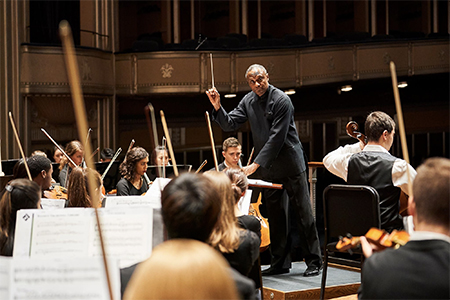by Nicholas Stevens

Wilkins cut a masterful figure onstage at Severance Hall. Music director of the Omaha Symphony and principal conductor of the Hollywood Bowl Orchestra, among other posts, he conducts primarily from the hands and arms — and otherwise keeps his movements minimal. This contributes to an overall sense of clarity and focus, and makes even the smallest additional gesture, such as a step or turn, feel like an event worth attending to. The method yields stunning results. Clevelanders should hope that he returns soon.
The program commenced with Shostakovich’s Festive Overture, which featured distinguished playing by the trumpets and violins. Alexandra McGuire delivered a controlled and pitch-perfect performance on piccolo, and concertmaster Marianne Martinoli set a precedent for strong leadership that would hold throughout the program.
Soloist Daniel Kaler excelled in Walton’s Cello Concerto. His tone — lithe, compact, and silvery — suits the piece, which comes alive in moments of quiet mystery. Its first movement gives the impression of wandering through some vast ruin, lit only by occasional shafts of light. It offers cinematic sweep, and enough sinister chiming to have kept harpist Ina McCormack and celesta player Jonathan Mak busy. Principal horn Rachel Lauson executed vast leaps with singing tone in thin textures, sounding assured.
Ending the movement with his first impeccable series of harmonics in a piece full of them, Kaler showed still more prowess in the lighter second movement. Surging upwards to more spotless harmonics, plucking passages with remarkable warmth and resonance, and rendering a high solo with intensity, he made it his own. Later, Kaler tackled unaccompanied passages with technical finesse, palpable expression, and musicianship to burn. After these solos, Walton’s music returns to the haunted feel of the opening. To end the piece, the cellist must fade to silence, alone, while bowing the instrument’s lowest note. Kaler executed it perfectly.
Aching passion suffused the first movement of Tchaikovsky’s Symphony No. 5. Led by principal trombone Christopher Brosius and tubist Carter Loud, the low brass stoked sonic heat and intensity. The low strings nailed the opening of the second movement, and Willem Crone showed both flexibility and dynamic control as he floated through the famous horn solo.
With Wilkins at the helm, the symphony’s loud moments crackled and sparked, and the brass sound became cataclysmic at climactic moments. Timpanist Angelo Antinori played with precision and taste in the brilliant non-sequitur of a waltz. Although the Orchestra could have followed Wilkins’s shifts in tempo more closely in the finale, the victorious conclusion was well-earned.
Published on ClevelandClassical.com October 8, 2018. Revised October 10 to correct the soloist’s name.
Click here for a printable copy of this article



